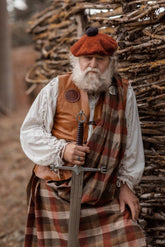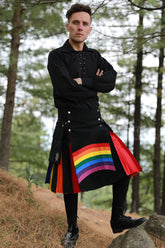Famous Tartans Associated with Scotland
What is Tartan?
Tartan is a patterned cloth consisting of criss-crossed, horizontal and vertical bands in multiple colors, forming simple or complex rectangular patterns. It is primarily associated with Scotland, especially seen in Scottish kilts. The earliest tartan-style cloth dates back around 3,000 years, found in Xinjiang, China. Scottish tartan was originally associated with the Highlands, and early tartans were only particular to locales, rather than any specific Scottish clan. The Dress Act of 1746 sought to control Highland dress, impacting tartan usage, but tartan gained widespread recognition as Scotland's national dress in the 19th century. Tartan usage expanded beyond Scotland, influenced by Scottish culture, and tartan-styled patterns exist in various cultures, such as Japan, Russia, Maasai, Bhutanese, and Indian. Tartan is a 2/2 twill weave, producing a distinct diagonal pattern, and the "sett" refers to the pattern of a particular tartan. Dive into the vibrant world of Scottish tartans – a kaleidoscope of criss-crossed colors, weaving tales of tradition and style. Unleash the allure of tartan, from the historic Highlands to contemporary chic. Wrap yourself in the legacy of Scotlad with curated tartans!

Famous Scottish Tartans
Here are 15 famous tartans that are associated with Scotland:
MacLeod of Lewis tartan
The MacLeod of Lewis Tartan is associated with the MacLeod clan, which traces its lineage from Leod, son of Olaf the Black, King of Mann and the Isles, born around 1200. The clan was involved in conflicts, including battles against Mackays and support for Donald Gruamach MacDonald of Sleat. Feuds in the 16th and early 17th centuries led to the decline of Clan MacLeod of The Lewes, and lands were lost to Clan Mackenzie due to internal conflicts. Ruairi Macleod's actions led to the fall of the clan, loss of Lewis, and eventual colonization attempts.
The MacLeod of Lewis Tartan is predominantly yellow and features black and red lines running across it, the vibrant yellow, symbolizing warmth and energy, black lines add a sense of strength and depth to the tartan, while the red lines introduce a touch of passion and intensity. The typical tartan is called 'modern', which refers to the richly colored chemical dyes that revolutionized the production of tartan in the 19th century. This Tartan is a symbol of the MacLeod clan and is worn by members of the clan and those who wish to show their affiliation with the clan.
Mackenzie Tartan
The Mackenzie tartan, steeped in the rich history of Clan Mackenzie, originates from the Scottish Highlands. Established in the 12th century, the clan played a pivotal role in the Wars of Scottish Independence, supporting Robert the Bruce, and feuding with neighboring clans such as the Earls of Ross, Munro, and MacDonald in the 14th-16th centuries. In the 17th century, the Mackenzie chief became Earl of Seaforth, and the clan's territory expanded from Black Isle to the Outer Hebrides. The Mackenzie tartan is a military tartan and was developed by Mackenzie Lord MacLeod's 73rd Highland Regiment, which was later taken over by the Seaforth Highlanders.
The colors of the Mackenzie tartan are red, green, blue, black, and white. The red, bold and resolute, echoes the fiery spirit that courses through the veins of the clan. Green, a verdant embrace, symbolizes the enduring connection to the lush landscapes that cradle their heritage. Blue, deep and boundless, mirrors the expansive skies and waters that have witnessed the saga of the Mackenzies unfold. Black, a shadowy sentinel, stands as a testament to the trials and tribulations faced with unwavering resolve. White, a canvas of purity, encapsulates the untarnished essence of their lineage. This tartan is known for its historical significance and unique design, which has been adapted by various organizations and individuals over time.
Buchanan Tartan
The Buchanan Tartan is a symbol of the Scottish Clan Buchanan, which traces its roots to a 1225 land grant to Sir Absalon of BuchananTraditional origin links the clan to Anselan O Kyan, an Irish king, landing in Argyll in 1016. However, recent DNA testing challenges the traditional Irish origin, establishing Clan Buchanan's presence on Loch Lomond shores before 1000 A.D. The clan supported King Robert the Bruce during the Wars of Scottish Independence and was involved in battles like Baugé and Verneuil. The Buchanan Tartan has undergone significant changes in heraldry during the 15th century, influenced by historical events.
The colors of the Buchanan Tartan are red, yellow, green, blue, and white. The tartan is asymmetrical in design, which is a rare feature among tartans. This Tartan is officially recognized as an old Scottish clan based on genetic evidence. The colors of the tartan have symbolic meanings: red represents strength and valor, yellow represents generosity, green represents hope, blue represents loyalty, and white represents purity.

Black Watch tartan
The Black Watch Tartan traces its origins to 1725, born from the collaboration of clans Campbell, Fraser of Lovat, Munro, and Grant in the "Independent Highland Companies." Renamed in 1739, it became an integral part of the British Army, gaining respect for unwavering dedication. The tartan witnessed pivotal battles such as Fontenoy, Culloden, and participation in major conflicts like the Crimean War and both World Wars. It bears witness to centuries of valor and sacrifice, reflecting Scotland's rich heritage.
The Black Watch Tartan's distinctive design features a grid-like pattern adorned with deep blue, rich green, and profound black stripes. Delicate black lines along the edges add intricacy, reflecting centuries of valor and sacrifice. Symbolizing Scotland's martial tradition, its colors embody the Highlanders' readiness to defend honor, echoing the motto "Nemo Me Impune Lacessit." Beyond military ceremonies, civilians don this black watch kilt, fostering a cultural continuity that invites all to connect with history. It is considered an open tartan, which means it is acceptable for anyone to wear, regardless of affiliation.
MacGregor Tartan
Founded in the early 9th century, Clan Gregor, or Clan MacGregor, originated in the Scottish Highlands, holding lands in Glen Orchy, Glenlochy, and Glenstrae. The first chief, Gregor of the golden bridles, led the clan through conflicts with Clan Campbell, marked by the capture and murder of Gregor Roy MacGregor in 1570. The 17th-century saw the MacGregors facing severe persecution, with James VI issuing an edict in 1603 abolishing their name. Despite enduring hardships, Rob Roy MacGregor played a crucial role in the Jacobite cause and the 1715 uprising. Today, Sir Malcolm Gregor Charles MacGregor, the 7th Baronet of Lanrick and Balquhidder, proudly leads Clan Gregor, marking the triumphant restoration of their heritage.
The MacGregor Tartan's distinctive palette of red, green, and white reflects the clan's resilience. Amidst persecution in the 17th century, the vibrant hues stood as symbols of endurance. Red signifies courage and strength, green embodies the clan's connection to the Scottish landscape, while white represents purity and hope. The tartan's intricate pattern weaves a narrative of the clan's history, from conflict to restoration.
Lindsay Tartan
The Lindsay tartan has a rich history dating back to the 12th century in Scotland. The Lindsay clan, founded in Scotland in 1120, had influence in both England and Scotland but relinquished English lands during the Scottish Wars of Independence. The clan's motto, "Endure forte" (Suffer bravely), reflects their indomitable spirit, while the clan crest features a swan rising from a coronet, symbolizing grace and nobility.
The Lindsay tartan typically features a palette of muted earthy tones, including shades of green, blue, and red. These colors are thought to represent the natural landscape of Scotland, with green symbolizing the lush countryside, blue reflecting the country's rivers and lakes, and red signifying the historic significance of the tartan. The pattern itself consists of intersecting lines and squares, creating a distinctive and recognizable design that is synonymous with Scottish tradition and pride.

Fraser Tartan
The history of Clan Fraser is a tale dating back to the early 1300s when the Frasers established themselves in what has ever since been recognized as the Lovat Fraser homeland – Beauly and the Aird. The clan has a rich and storied past, with notable events including tragedies and triumphs that have shaped its identity. The Frasers of Lovat have been prominent in the local politics and military of Inverness-shire, and the clan's influence has extended to various regions in Scotland, including Stirling, Angus, Inverness, and Aberdeen. Today, the Clan Fraser Society of Scotland & the UK continues to celebrate and preserve the heritage of the Frasers, organizing events and gatherings for members to connect with their ancestry and learn about the clan's history.
The iconic Fraser tartan features a dominant red with green, blue, and white accents, each color holds symbolic significance. The dominant red represents strength, courage, and passion, reflecting the resilience of the Fraser clan. Green, another prominent color, symbolizes growth, nature, and the lush landscapes of Scotland, while blue signifies vigilance, perseverance, and loyalty. These colors come together in the tartan's pattern, creating a visually captivating design that embodies the heritage and values of the Fraser clan. Additionally, white, though not as dominant, represents purity, simplicity, and elegance in some variations of the tartan. Overall, the colors in the Fraser Tartan carry deep cultural and historical meaning, making it a significant symbol of Scottish heritage and the Fraser clan's legacy.
Royal Stewart tartan
Clan History: The history of the Royal Stewart clan is rich and deeply intertwined with Scottish royalty. The family traces its traditional descent from Banquo, Thane of Lochaber, and has ancient roots in Brittany, England, and Scotland. The Stewarts acquired extensive estates in Renfrewshire and East Lothian and played a significant role in Scottish and English monarchy, with the present Royal family still having Stewart blood links. The clan is associated with various branches, including the Stewarts of Appin, who were staunchly Jacobite and played a role in the famous Appin murder, immortalized by Robert Louis Stevenson in his novel 'Kidnapped'. The Stewarts have close ties to Scottish royalty, producing several kings and queens of Scotland, and their rule marked a transformative era in Scottish and British history.
The Royal Stewart tartan features a striking pattern with colors including red, blue, green, black, yellow, and white. The red, white, and blue stripes symbolize passion and the Scottish landscape, while the green and blue borders represent the Scottish countryside. This iconic tartan has several variations, each with its own significance, and is worn by members of the Royal Family and various civilian and military groups, reflecting its enduring appeal and versatility. The Royal Stewart tartan's vibrant colors and distinctive pattern have made it a beloved symbol of Scottish heritage.
Douglas Tartan
The Douglas clan, a prominent Lowland Scottish clan, has a rich history dating back to the 14th and 15th centuries, during which they became a powerful force in Scottish history. The Douglas Tartan, symbolizing Scottish heritage, represents the clan's origins in Lanarkshire in the 12th century. The Black Dinner tragedy in 1440, where young William Douglas and his brother were falsely accused of treason and executed, inspired the clan's motto "Jamais Arrière" ("Never Behind"). Known for their political astuteness, the clan secured vast land ownership and established themselves as key figures in Scottish politics. The clan crest, featuring a salamander engulfed in flames, symbolizes the Douglases' resilience and ability to overcome challenges. Wrapping oneself in the Douglas Tartan embodies the clan's storied history and spirit, encapsulating their legacy of defying expectations and forging destiny.
The Douglas Tartan, a vibrant and visually striking Scottish tartan, is characterized by a color palette that includes dark green, navy blue, royal blue, black, and white, which together create a masterpiece reflecting the Scottish landscape. The pattern features a series of horizontal and vertical lines, with the colors repeated in a way that evokes a sense of movement and depth, symbolizing the strong and resilient nature of the Douglas clan. Green represents a connection to the land, black symbolizes strength, blue embodies loyalty, and white stands for purity, each color holding a special meaning in the tartan's design. The Douglas Tartan's representation of these colors and its intricate pattern make it a popular choice for both traditional and modern settings, reflecting the rich history and cultural significance of Scottish tartans.

Armstrong Tartan
The Armstrong Clan is a Scottish clan with a rich history dating back to 1610, marked by the daring end of their final leader, Archibald Armstrong, in a cattle raid on Penrith. The clan originates from the Scottish Highlands and is known for their indomitable spirit and motto "Invictus Maneo." The Armstrong Crest features fierce symbols, including lions and a crescent moon, encircled by an intricate border, reflecting their noble lineage. This clan originated from the Scottish Borders and Northumbria, playing a pivotal role in Anglo-Scottish conflicts and leaving a lasting mark on history. Gilnockie Tower, erected in 1520 by Johnnie Armstrong, stands by the River Esk, preserving tales of the clan's trials, triumphs, and enduring resilience. The saga of the Clan is characterized by a captivating blend of history, symbolism, and artistic representation in their tartan.
The Armstrong Tartan is characterized by its unique combination of green, navy, red, and black colors, which represent the clan's connection to the Scottish Highlands' lush greenery, expansive skies, valor, and legacy. The green and navy stripes symbolize growth, stability, and professionalism, while the red and black stripes signify passion, strength, and courage. The pattern is inspired by the Armstrong Clan's crest, which features an arm from the shoulder, armed, in the center of the strap and buckle, framed by the motto "Invictus maneo" (I remain unvanquished).
Cameron Tartan
Clan Cameron is a West Highland Scottish clan with a rich history dating back to the 14th century. The clan's Gaelic name is "Camshron," translating to "Crooked nose," and its badge features a sheaf of five arrows tied with a band in Gules, symbolizing strength and unity. Clan Cameron traces its roots to the legendary King Fergus II of Denmark, and the transition into Clan Cameron as known today happened during the 15th century. The clan stood alongside Bonnie Prince Charlie in 1745, showcasing bravery in historic battles such as the Battle of Culloden. Despite facing tumultuous times, the Camerons have maintained their proud legacy and continue to celebrate their rich heritage.
The Cameron tartan, features a unique combination of red, green and yellow colors pattern that represent the clan's history and spirit. The dominant red background symbolizes strength and passion, reflecting the resilience of the clan. The green and yellow stripes represent the vibrant history and unyielding spirit of the Cameron clan, showcasing their connection to the natural landscape of Scotland and their unwavering determination.These colors are available in different shades, such as "modern" (bright and lively colors) and "ancient" (supposedly more authentic colors) . The tartan's design is intricate and meaningful, making it a powerful symbol of tradition and heritage for the clan.
Anderson Tartan
The Anderson Clan, a Scottish clan recognized by the Lord Lyon King of Arms, has a rich history dating back to the 13th century. The clan's name is believed to have Greek origins, meaning manly or brave. The Anderson Clan played a significant role in the Border Reivers and the Scottish Wars of Independence in the 16th century. The clan's motto is "Stand Sure," and the crest features an oak tree. Although this tartan is unique among Scottish tartans, with seven colors instead of the typical six or less.
The Anderson tartan, with its seven colors including dark blue, green, black, red, yellow, white, and navy, is a unique symbol of Scottish heritage. The dark blue represents the highland rivers and the sea, while the green reflects the fertile plains of Mar and the grassy banks of the rivers Dee and Don. Black symbolizes the Clan's military aspect, red represents the blood shed in wars, yellow symbolizes wealth, and white represents purity and innocence. This vibrant and varied color palette encapsulates the diverse and colorful history of the Anderson Clan, making the tartan a cherished emblem of Scottish pride.

Graham Tartan
Clan Graham, with roots dating back to ancient times, has a rich heritage and historical bravery, notably at the Battle of Dunbar in 1296. The clan's motto "Ne Oublie" reflects their enduring legacy. James Graham, 3rd Duke of Montrose, played a pivotal role in the clan's history by repealing the Dress Act in 1782 and advocating for the wearing of Highland dress. The clan's connection with Macnaughton is evident in the painting "Montrose" at the National Gallery, featuring the Red Graham of Montrose tartan. Clan Graham's crest, a falcon preying on a stork, symbolizes their heritage, with lands spanning Loch Katrine, Perthshire, Dundee, and Montrose.
The Graham Tartan, a Scottish clan tartan, is characterized by its unique pattern and color scheme, which includes black, blue, and green colors. These colors represent specific traits, such as strength and stability (black), vigilance and loyalty (blue), and growth and harmony (green). The pattern of the Graham Tartan has been passed down through generations and has been woven into various forms, such as textiles and clothing, showcasing the beauty and craftsmanship of Scottish tartan design. This tartan is not only a symbol of the Clan Graham's history but also a representation of the Scottish community and its cultural traditions.
Johnston Tartan
The Johnstone Clan, a Scottish clan dating back to the 13th century, has a rich history rooted in the region of Annandale. As powerful forces in Scottish society, they were loyal supporters of the monarchy and defenders of the Scottish borders. James Johnstone, a prominent member of the clan, served as the Secretary of State for Scotland in the early 18th century and played a crucial role in negotiating the Union of Scottish and English parliaments in 1707. The Johnstones were dedicated border patrols between Scotland and England for over 600 years, and their legacy is preserved in the Johnstone Tartan. The modern Johnstone Clan continues to honor their heritage and traditions, keeping them alive through the Johnston Tartan.
The Johnston Tartan boasts a distinctive combination of black, green, blue, and white hues. Each color carries profound symbolism, with black representing strength, green signifying the lush Scottish landscapes, blue symbolizing loyalty, and white embodying purity. The interplay of these colors in a timeless pattern not only reflects the clan's identity but also encapsulates the enduring spirit of the Johnston lineage. This tartan serves as a visual testament to the rich tapestry of the Johnston clan's past, present, and future.
Gordon Tartan
The Gordon clan has a rich history spanning generations, symbolizing resilience, loyalty, and Scottish heritage. The Gordon Tartan encapsulates the profound legacy of Clan Gordon, showcasing its indomitable spirit rooted in the heart of the Scottish Borders and Aberdeenshire. The clan's motto, "Bydand" (Remaining), reflects an unwavering commitment to their roots and is a testament to their resilience. Sir Adam and Sir Alexander Gordon played pivotal roles in shaping the clan's history. Sir Adam Gordon, a supporter of Robert the Bruce, sought the Pope's assistance to reverse Bruce's excommunication, a significant chapter in Scotland's struggle for independence. The Gordon Tartan's selection as the Regimental tartan underscores its role in military history, specifically with the Gordon Highlanders.
Gordon Tartan's resplendent design features a dark green canvas adorned with a harmonious blend of navy blue, black, and yellow stripes. Each color holds significance, with dark green symbolizing the clan's connection to nature, while navy blue and black evoke a sense of strength and loyalty. The yellow stripes add a touch of vibrancy, representing the clan's adaptability. Together, these colors form a timeless pattern that not only reflects the Gordon Clan's history but also encapsulates unity and diversity within its intricate weave.
Buy a Tartan of Your Choice!
Discover your own style with Fashion Kilt's 140+ cool tartans! Choose from lots of awesome designs that show off your unique taste. Discover your perfect tartan from our thoughtfully curated designs, offering a mix of heritage and contemporary flair. Pick a perfect tartan for kilt clothing that exudes timeless elegance, ensuring both comfort and authenticity, mix of old and new, blending tradition with modern vibes. Pick a pattern that feels just right for you—it's like wearing a piece of art! At Fashion Kilt, we make sure each kilt is top-notch quality, so you're getting something special. Rock the classic look of tartan, and with us, show off your awesome style that says a lot about who you are.
FAQs
Can anyone wear these tartans, or are there restrictions?
While some tartans, like the Royal Stewart, were originally designed for specific individuals or families, most Scottish tartans are now available for anyone to wear. The tradition is about honoring a community or cause, and there is no rule stopping someone from wearing a tartan they love or even just like the look of.
How have Scottish tartans influenced fashion and culture?
Scottish tartans have had a significant impact on fashion, with tartan kilts being a symbol of rebellion against English imperialism. They have also been seen in street wear, high fashion, and even on biscuit tins for shortbread.
What is the meaning behind the colors and patterns of Scottish tartans?
The colors and patterns in Scottish tartans have symbolic meanings. For example, the colors black, red, and white signify the French royal colors of the Stewarts, who were the ruling monarchs of Scotland. The colors also represent the three kingdoms of Scotland, with red for the Scots, white for the English, and black for the Irish. Tartan designs are often passed down through generations, and the patterns tell stories or represent the history of the family or clan.
How have Scottish tartans evolved over time?
Scottish tartans have evolved over time, with the earliest evidence of tartans dating back to the 13th century. The patterns have changed and adapted to different historical periods, such as the Renaissance and the Romantic era, and have been influenced by various cultural influences. Today, tartans are used in modern fashion, accessories, and even in virtual environments like video games.
What is the process for creating a new Scottish tartan?
Creating a new Scottish tartan involves several steps, including researching the family or clan's history, selecting colors and patterns that represent their story, and submitting the design to the Scottish Tartan Authority for approval. The STA is the official registry for new tartans and ensures that the design is unique and of high quality. Once approved, the new tartan can be used for various purposes, such as clothing, accessories, and other items that celebrate the family's or clan's heritage.













